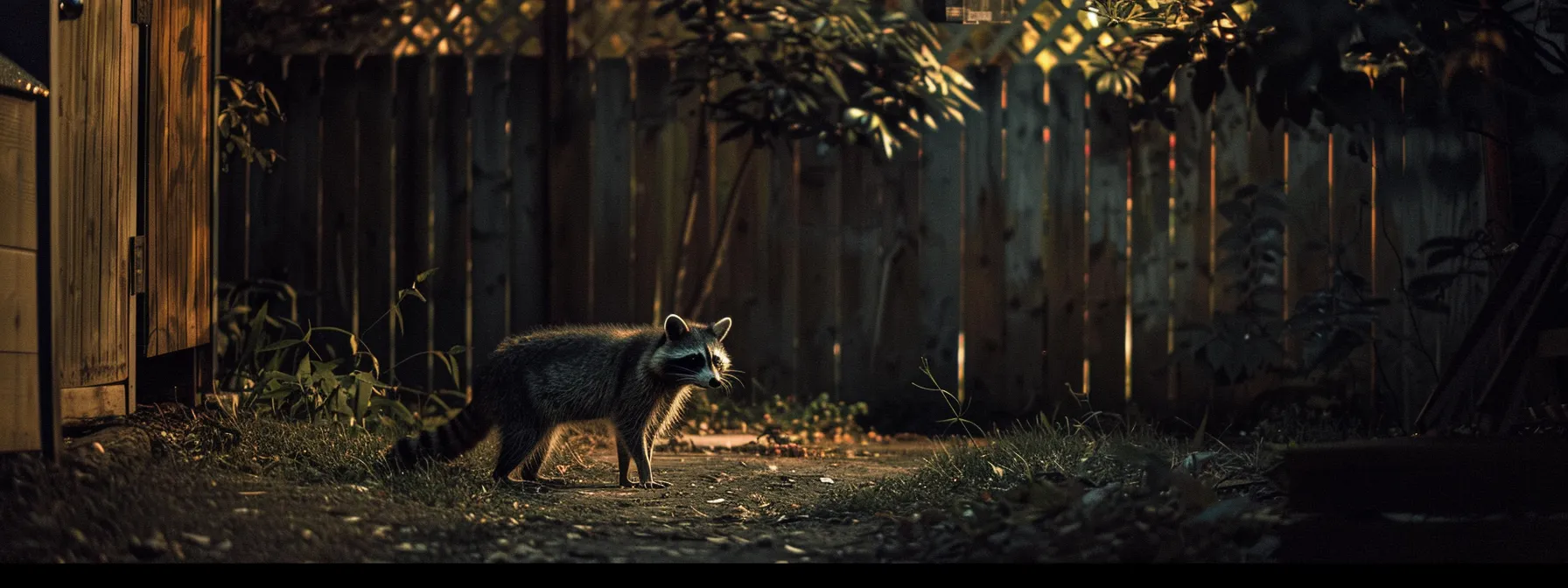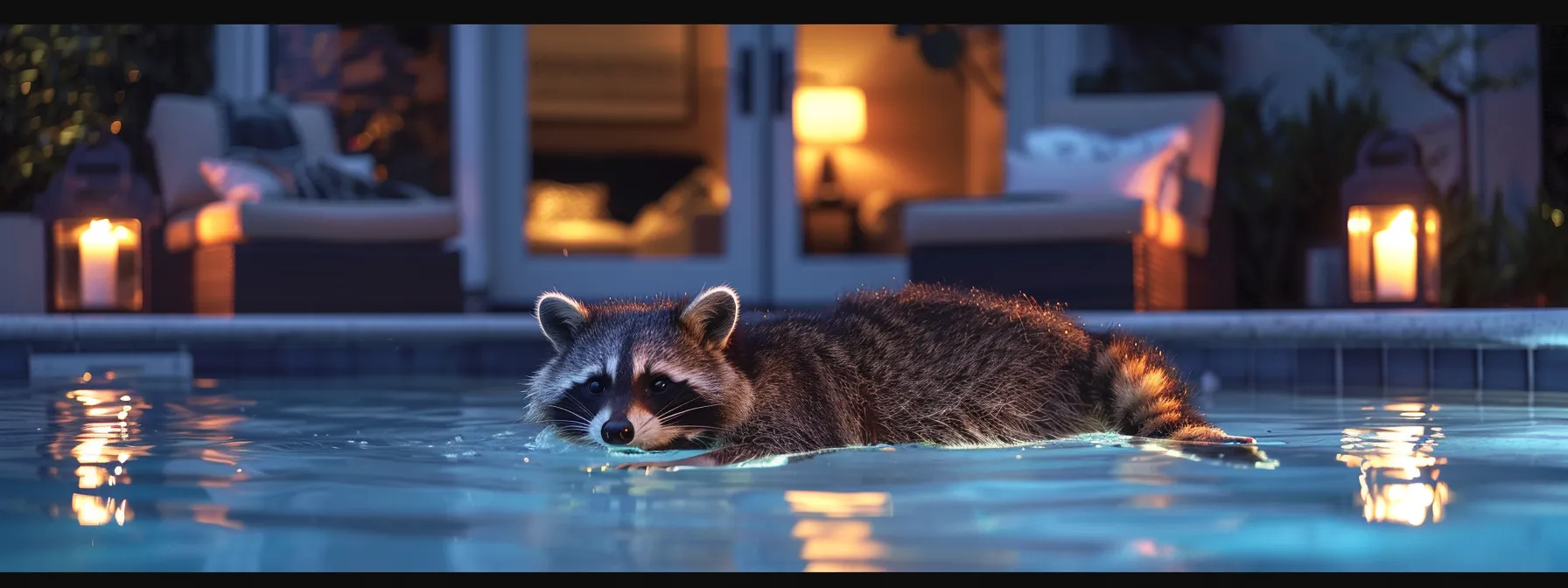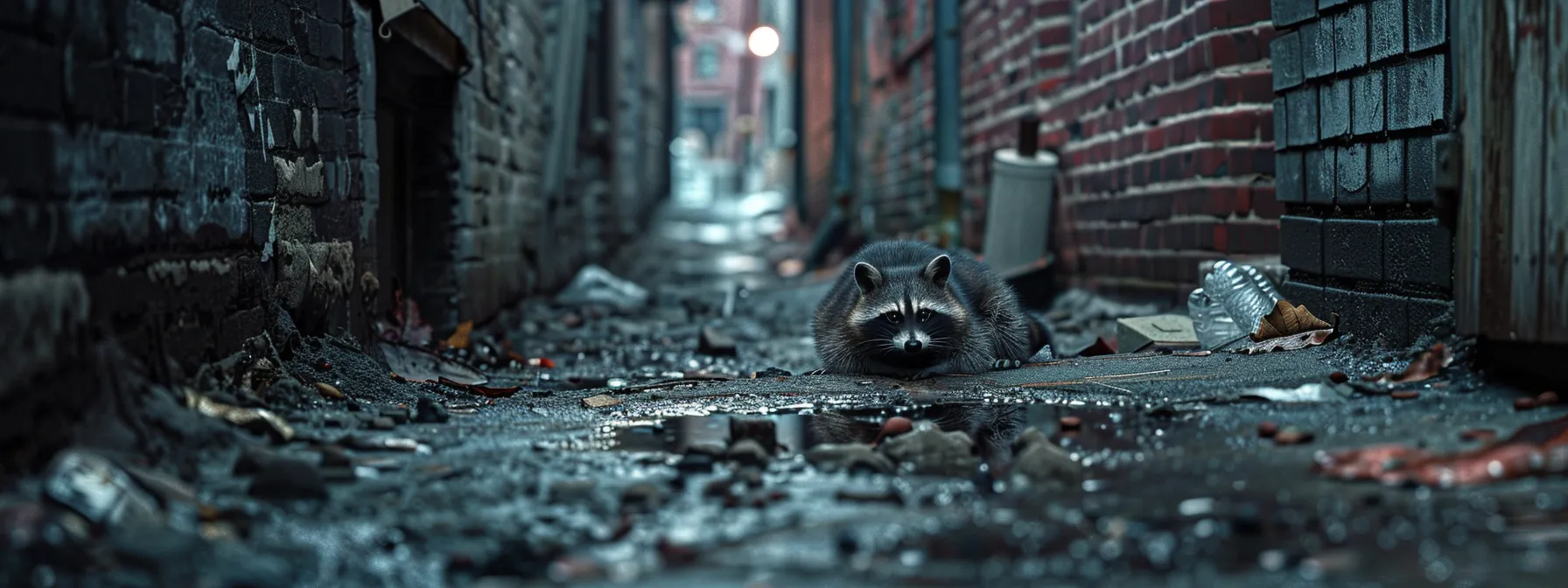
Nocturnal Raccoon Habits That Surprise Homeowners
Raccoons are more than just cute creatures; they are skilled nocturnal animals that can surprise homeowners with their behaviors. From their unexpected dexterity to their complex social interactions, these animals exhibit habits that may challenge common perceptions. This article will explore how raccoons utilize their dexterity, navigate their social lives, and display unique denning choices. Understanding these habits can help homeowners address potential issues and appreciate the adaptability of raccoons, ultimately fostering a safer living environment.
Unexpected Dexterity Skills Under the Cover of Darkness

Raccoons exhibit surprising dexterity during nighttime foraging. They skillfully open bins and latches, accessing pet food and other attractants, including exclusions. Observers often witness their adept manipulation of various objects, showcasing their intelligence and problem-solving abilities. Their climbing feats allow them to reach elevated areas, including crawl spaces, providing insights into their body language and nocturnal behaviors.
How Raccoons Open Bins and Latches at Night
Raccoons have developed remarkable adaptation skills that allow them to manipulate various objects, including bins and latches, with ease. Their dexterity is a significant part of their social behavior, as they often learn from one another how to access food sources. This intelligence demonstrates a keen understanding of their ecology, enabling them to thrive in urban environments where opportunities for foraging abound.
When a raccoon approaches a bin, its first instinct is to assess the situation by inspecting the latch mechanism. They utilize their nimble paws to probe and unfasten even the most secure closures, often surprising homeowners who believe they have taken adequate precautions. As these critters stop to forage, their uncanny problem-solving abilities become apparent, making it essential for residents to fortify against these cunning nocturnal foragers to protect their nests from unwanted invasions.
Observing Raccoons Manipulating Objects With Their Paws
Raccoons exhibit a remarkable capability for manipulating objects, a skill that becomes especially evident during their nocturnal foraging. Utilizing their exceptional night vision, these urban wildlife creatures expertly navigate dark environments, making them adept at accessing waste materials and food sources that other pests might overlook. Residents often find them rummaging through bins, showcasing their ability to unfasten locks or lids with surprising efficiency, which underscores the need for effective pest management solutions.
When homeowners observe raccoons engaging in this behavior, it serves as a clear indicator of their intelligence and adaptability. These urban foragers not only identify accessible food but also learn techniques from fellow raccoons, making it essential for property owners to consider professional trapping services. Implementing effective deterrents and securing waste will minimize these encounters, ensuring a peaceful coexistence with the local wildlife while protecting homes from potential damage caused by these skilled foragers.
Nighttime Feats of Climbing and Accessing High Places
Raccoons are exceptionally skilled climbers, enabling them to navigate diverse landscapes with ease. In North America, these agile animals can often be found scaling trees, fences, or rooftops in search of food. This ability to access high places is crucial, as it allows them to reach garbage bins and other food sources that may be out of reach for less agile creatures such as opossums.
Homeowners may be surprised to find raccoons taking advantage of elevated positions, especially in suburban areas bordering wetlands. Their climbing prowess can lead them directly to potential entry points, creating opportunities to invade homes or access exterior waste storage. Understanding these nocturnal habits can assist homeowners in implementing effective strategies to safeguard their properties and minimize encounters with these clever foragers.
Raccoon Nocturnal Behavior Insights Into Problem Solving
Raccoons display intriguing nocturnal behaviors that highlight their problem-solving skills during nighttime foraging. In their natural environment, these animals exhibit a keen awareness of their surroundings, allowing them to assess potential food sources effectively. Their ability to navigate dark spaces enhances their foraging success, often catching homeowners off guard when they discover how adept these creatures are at accessing unsecured garbage or pet food.
During the night, raccoons engage in meticulous exploration, employing their intelligence to overcome obstacles. For example, when facing a locked container, they observe and experiment, demonstrating remarkable cognitive capabilities similar to those exhibited during periods of hibernation when other species are inactive. Homeowners benefit from understanding these behaviors, as proactive measures—such as securing outdoor waste and using raccoon-proof containers—can significantly reduce unwanted encounters with these resourceful foragers.
As the night deepens, the world becomes a stage for more than just skilled movements. Beneath the cloak of darkness, intricate social bonds unfold, revealing stories that often go unnoticed.
Complex Social Lives After Sundown

Raccoons exhibit intricate family units that forage together at night, highlighting their complex social behaviors. Surprising communal denning practices offer insights into their adaptability amid urbanization. Nighttime interactions among unrelated raccoons reveal their social dynamics, while territorial markings and communication through feces provide essential information about their habitat and risk management, underscoring the importance of wildlife conservation efforts.
Raccoon Family Units Foraging Together at Night
Raccoon family units often forage together at night, showcasing their complex social structures. These intelligent creatures exhibit behaviors that strengthen their ties, such as sharing territory and resources during their nightly inspections for food. While foraging, raccoons can sometimes be seen alongside other nimble animal residents like skunks, indicating their adaptive strategies in urban settings where competition for food is high.
During the gestation period, a mother raccoon relies on her family for support, which can influence the survival of her young. This cooperative behavior demonstrates the importance of these social units in navigating their environment efficiently, as they collectively explore and exploit available food sources. Homeowners may notice increased activity during this time, as raccoons are more resourceful when collaborating, often leading to unexpected visits to backyard bins and gardens.
Surprising Communal Denning Behaviors Observed
Raccoons exhibit fascinating communal denning behaviors that catch many homeowners off guard. During mating season, these social species often gather in groups to establish shared living spaces, utilizing their keen sense of smell to locate suitable dens. This behavior not only enhances their chances of raising young collectively but also emphasizes the importance of understanding local wildlife dynamics for effective raccoon removal and pest control services.
These collaborative habits allow raccoons to efficiently explore their environment and find food sources, as they tend to forage together at night. Homeowners may notice increased raccoon activity near denning sites during this time, which can present challenges if proper precautions are not taken. Recognizing these nocturnal patterns can help property owners implement effective strategies to secure their homes and reduce the likelihood of unwanted visits by these resourceful foragers.
Nighttime Interactions Between Unrelated Raccoons
During the nighttime, unrelated raccoons often engage in complex social interactions that reveal their natural behaviors and establish a dominance hierarchy. These skilled foragers may be spotted near home roofs or in attics, where they sometimes compete for food or territory. Understanding these interactions can help homeowners identify potential risks, such as unexpected visits to basements or other entry points where raccoons might seek shelter or food.
The social dynamics between different raccoon groups are influenced by their need to assert dominance, which can lead to vocal communications and posturing. Observing these behaviors near residential areas can offer homeowners valuable insights into the activity levels of local raccoons, especially during warmer months when they forage actively. Being proactive about securing garbage and using appropriate deterrents can significantly reduce the likelihood of raccoon encounters, ensuring a more peaceful environment.
Territorial Markings and Communication After Dark
Raccoons mark their territories using various methods, such as leaving scent trails from glands located on their paws. This behavior serves not only to establish dominance but also to communicate with other raccoons in the vicinity. Homeowners may find it surprising when these nocturnal animals leave their scent marks, as it highlights their complex social structure and need for space, which can lead to increased encounters in residential areas.
During nighttime, raccoons engage in vocalizations to establish their presence and communicate with other wildlife. Understanding these signs can help homeowners recognize potential risks associated with raccoon activity, such as seeking food sources or lodging in attics and basements. Effective wildlife removal strategies are essential, particularly for those concerned about raccoons causing damage or creating fear and disturbances near their homes, especially when coupled with other pests like mosquitoes that may thrive in unregulated environments.
The darkness holds more than shadows; it carries the voices of a complex society. Raccoons express their world through a wide range of sounds, each revealing a layer of their nocturnal interactions.
A Wide Range of Raccoon Vocalizations Heard at Night

Identifying different raccoon calls in the dark is key for homeowners to understand their nocturnal behaviors. Chitters and growls play crucial roles in raccoon communication, with mother raccoons using specific sounds to call their kits during the night. Homeowners may also mistake unusual sounds for other animals, such as groundhogs, complicating the management of potential infestations and health risks, including concerns over canine distemper. Understanding these vocalizations helps residents recognize raccoon activity and take appropriate measures to safeguard their properties.
Identifying Different Raccoon Calls in the Dark
Homeowners may find themselves startled by the variety of vocalizations made by raccoons during the night. These sounds can range from soft chitters to loud growls, each serving a distinct purpose in communication. For instance, a mother raccoon may emit specific calls to summon her kits, signaling their need for safety or food, such as seeds or other local edibles, that she has discovered nearby.
Recognizing these vocal patterns can significantly assist homeowners in identifying raccoon presence and potential issues. The distinct sounds can indicate social interactions, territorial claims, or food searches, helping residents determine if their outdoor spaces are attracting these agile foragers. By understanding these calls, it becomes easier to implement effective strategies for limiting encounters and ensuring that raccoons do not become a nuisance or a source of concern.
What Chitters and Growls Mean in Raccoon Communication
Chitters and growls emitted by raccoons serve distinct purposes within their communication repertoire. Chitters often signal the presence of excitement or curiosity, while growls can indicate a warning or establish dominance among raccoons. Homeowners hearing these sounds during the night may interpret them as signs of activity, suggesting that raccoons are nearby, which could lead to potential issues such as foraging through unsecured trash or accessing gardens.
Understanding the significance of these vocalizations is essential for homeowners seeking to manage raccoon encounters effectively. For instance, if a homeowner hears persistent chittering, it may indicate that a mother raccoon is summoning her kits or interacting with nearby raccoons. Recognizing these behaviors allows residents to implement preventive measures, ensuring that food sources are secured and minimizing the likelihood of raccoons becoming a nuisance in their outdoor spaces.
Mother Raccoons Calling Kits During Night Hours
During nighttime, mother raccoons rely on vocalizations to communicate with their kits, employing specific sounds to gather them when foraging. These calls are crucial for maintaining the safety and coordination of the family unit as they navigate their surroundings for food. Homeowners who experience these calls may be surprised by the complexity of these interactions, revealing just how social and attentive raccoons are as parents.
Understanding the sounds that mother raccoons make helps homeowners recognize the presence of young raccoons nearby, indicating a potential increase in activity around their properties. When homeowners become aware of the significance of these vocalizations, they can take proactive measures to secure garbage or outdoor food sources, minimizing potential foraging and disturbances caused by these clever creatures during their nightly excursions.
Unusual Sounds Homeowners Mistake for Other Animals
Many homeowners may encounter unusual nighttime sounds, often attributing them to animals such as raccoons. The distinct chittering and growling produced by raccoons can sometimes resemble the calls of other wildlife, leading to misconceptions about what is causing the disruption. This confusion can result in unnecessary concern or misdirected attempts to manage the situation when, in fact, understanding the source of these vocalizations can clarify whether wildlife removal or other measures are necessary.
Additionally, the nocturnal habits of raccoons can lead to mistaken identifications based on their sounds. For instance, the vocalizations that rattled homeowners might actually come from a mother raccoon calling her young, rather than larger or more threatening animals. By recognizing these specific raccoon sounds, residents can take more informed actions to secure their properties and effectively deter unwanted wildlife encounters, fostering a safer and quieter living environment.
The sounds of raccoons fill the night, each call telling a story of their restless movements. Just beyond the din, the pull of water beckons, revealing another side to these curious creatures.
Raccoons Affinity for Water Activities During Night Hours

Homeowners may find raccoons engaging in various water activities during the night, such as swimming or playing near ponds and pools. These locations attract raccoons due to the opportunity to douse food before consumption. Understanding these behaviors provides insights into how raccoons interact with aquatic environments, highlighting their adaptability and the reasons behind nighttime visits to residential water sources.
Finding Raccoons Swimming or Playing Near Water Sources
Raccoons are often observed engaging in playful water activities at night, drawn to ponds, pools, and even backyard water features. This behavior not only provides hydration but allows them to wash and manipulate food, enhancing their foraging efficiency. Homeowners may find these nocturnal visits surprising, especially when raccoons splash about, illustrating their adaptability in urban settings.
Understanding the affinity of raccoons for water sources can help homeowners anticipate potential disturbances. Property owners can implement measures such as securing pools and covering ponds to deter these clever foragers from turning aquatic areas into play zones. By recognizing these habits, residents can better protect their outdoor spaces from encounters with these agile nighttime adventurers.
The Practice of Dousing Food Before Eating at Night
Raccoons display a unique behavior of dousing their food in water before consumption, a practice that enhances their foraging success. This action not only serves to clean the food but also facilitates easier manipulation, particularly when dealing with items obtained from bins or outdoor spaces. Homeowners often find it surprising to see these agile creatures interact with water sources, as this habit showcases their adaptability and resourcefulness in urban environments.
This affinity for water can lead to unexpected challenges for homeowners, especially if raccoons begin frequenting pools or ponds to wash their food. Understanding this behavior provides insight into managing local wildlife interactions, allowing property owners to implement strategies such as securing food sources or covering aquatic areas. By addressing these nocturnal habits, residents can minimize potential disturbances and protect their outdoor living spaces from these clever foragers.
Why Ponds and Pools Attract Nighttime Raccoon Visits
Ponds and pools attract nighttime raccoon visits primarily because of the unique opportunities they present for hydration and food preparation. Raccoons are naturally drawn to water sources, using them to wash their food before consumption, which enhances their foraging experience. This behavior allows them to efficiently manipulate items obtained from outdoor spaces, making such locations appealing hunting grounds during their nocturnal excursions.
Moreover, pools and ponds often contain a variety of food sources, from fish to leftover snacks left by homeowners. This ready availability of food increases the likelihood of raccoons frequenting these areas at night. By understanding the reasons behind these nighttime visits, homeowners can take proactive measures, such as covering pools and securing food, to deter raccoons and minimize disruptions to their outdoor environments.
Raccoon Nocturnal Behavior Insights Around Aquatic Environments
Nighttime visits by raccoons to residential ponds and pools highlight their affinity for aquatic environments. These clever foragers utilize water sources not only for hydration but also for preparing food, washing items they retrieve from trash or outdoor areas. Homeowners may find this behavior surprising as raccoons exhibit remarkable dexterity in manipulating items, enhancing their foraging experience in urban settings.
Understanding raccoon interaction with water provides valuable insights for homeowners. The tendency of raccoons to frequent pools and ponds can lead to disturbances, especially if they begin to wash their food or play in these areas. By recognizing these nocturnal habits, property owners can take steps to secure their outdoor spaces, minimizing potential interactions and safeguarding against issues associated with these agile nighttime visitors.
Raccoons soak in the moonlit waters, reveling in their nightly escapades. Yet, it is their ability to thrive in urban settings that truly captivates, showcasing remarkable adaptation skills.
Astonishingly Clever Urban Adaptation Strategies

Raccoons effectively navigate complex urban landscapes after sunset, utilizing human structures for shelter and travel routes. They exhibit impressive memory skills regarding food sources and schedules, returning to favored spots consistently. Moreover, these clever animals employ various tactics to avoid detection by homeowners, ensuring they can thrive in close proximity to human activity.
Raccoons Navigating Complex Cityscapes After Dark
Raccoons demonstrate exceptional skills in navigating complex cityscapes after dark, utilizing their sharp senses to find food and shelter in urban environments. These animals have adapted to human presence, learning to avoid detection while skillfully maneuvering through alleys and backyards to access garbage bins or pet food left outdoors. Their ability to recall the locations of past food sources highlights their intelligence and memory, which further aids in survival in densely populated areas.
Homeowners may find it surprising how proficient raccoons are at using urban structures to their advantage. For instance, they often climb fences or scale buildings to reach rooftops and observe their surroundings, ensuring a clear path to food sources below. Understanding these nocturnal habits empowers property owners to take preventive measures, such as securing trash and using raccoon-proof containers, to minimize potential disturbances and safeguard their homes.
Utilizing Human Structures for Shelter and Travel Routes
Raccoons have mastered the art of utilizing human structures as shelter and travel routes in urban environments. Their agility allows them to climb fences, scale buildings, and navigate rooftops, enabling them to access food sources that would otherwise be out of reach. Homeowners may be surprised to see these clever creatures maneuvering through their properties, highlighting the necessity for effective wildlife management strategies to safeguard against unwanted encounters.
These nocturnal foragers often find refuge in attics, basements, and sheds during their nighttime excursions, making it essential for property owners to secure these potential entry points. By understanding how raccoons exploit human environments for shelter, homeowners can take proactive measures to prevent invasions and protect their living spaces. Implementing simple deterrents, such as securing trash bins and sealing openings, can minimize the risk of raccoons taking advantage of these human-made habitats.
How Raccoons Remember Food Sources and Schedules
Raccoons exhibit impressive memory capabilities, particularly when it comes to recalling food sources and schedules. These intelligent creatures often revisit locations where they have previously found nourishment, utilizing their sharp senses to navigate urban landscapes effectively. By observing patterns in human behavior, such as trash collection days, raccoons can time their foraging endeavors, maximizing their access to easily obtainable food resources.
This ability to remember food availability is crucial for raccoons, especially in areas with high human activity. Homeowners may find it surprising how these nocturnal foragers leverage their understanding of food schedules to return to the same locations repeatedly. By securing outdoor food sources and trash bins, residents not only deter raccoons but also minimize potential disruptions caused by these clever creatures during their nighttime explorations.
Surprising Ways Raccoons Avoid Detection by Homeowners
Raccoons have developed remarkable strategies to avoid detection by homeowners during their nighttime excursions. These clever creatures often rely on their keen senses and stealth to navigate urban environments, making them masters of evasion. For example, they may wait for a moment of relative quiet before approaching a trash bin, ensuring their movements go unnoticed while searching for food sources left unsecured.
By utilizing shadows and natural cover, raccoons minimize their visibility as they traverse the landscape. They may also adapt their foraging patterns based on human activities, choosing to venture out at times when residential areas are least active. This behavior not only highlights their intelligence but also emphasizes the importance of homeowners taking proactive measures—such as securing waste and monitoring for signs of raccoon activity—to prevent unwanted visits from these elusive nocturnal foragers.
Raccoons and squirrels often seek refuge in unexpected places, showcasing a blend of ingenuity and survival instinct. Their choice of denning sites extends far beyond traditional spaces, revealing new strategies in their quest for shelter.
Unconventional Denning Choices Beyond Attics and Crawlspaces

Raccoons often seek shelter in unexpected places, including storm drains and culverts at night. Homeowners may also find raccoon families residing in sheds or under decks, as these areas provide safety and warmth. Additionally, raccoons adapt to tree hollows in unconventional locations and utilize temporary night shelters while foraging. Recognizing these denning habits can help property owners implement effective prevention strategies.
Raccoons Occupying Storm Drains and Culverts at Night
Raccoons often seek refuge in storm drains and culverts during the night, utilizing these structures as unconventional dens that provide shelter and a strategic location for foraging. Homeowners may be surprised to learn that these areas not only offer protection from the elements but also provide easy access to nearby food sources, such as waste left unsecured outside residential properties. This behavioral tendency underscores the importance for property owners to regularly inspect and secure these potential entry points to prevent raccoons from taking up residence.
These nocturnal visitors typically utilize storm drains and culverts as temporary shelters while they explore urban landscapes in search of food. As raccoons are skilled at navigating these environments, homeowners should consider reinforcing drainage systems and maintaining clean surroundings to deter these clever creatures. By understanding the behavioral patterns of raccoons and their choice of shelter, residents can better protect their properties from uninvited nighttime visitors.
Finding Raccoon Families in Sheds or Under Decks
Raccoons often find shelter in sheds or under decks, surprising homeowners who may not consider these areas as potential dens. These spots provide safety from predators and a cozy environment for raising young. As they search for food, raccoons frequently choose these unconventional locations, highlighting the importance of being vigilant about securing outdoor structures and ensuring there are no easy entry points.
Homeowners should regularly inspect their sheds and deck areas for signs of raccoon activity, such as nesting materials or droppings. By sealing potential entry points and keeping these spaces tidy, residents can reduce the likelihood of raccoon families taking up residence in unwanted locations. Understanding these nocturnal habits is essential for effective pest management and protecting property from potential disturbances caused by these clever foragers.
Adapting Tree Hollows in Unexpected Locations
Raccoons display remarkable adaptability by using tree hollows in unexpected locations to establish their dens. In urban areas, these clever animals might take advantage of old, hollow trees situated near homes, transforming them into safe havens for shelter and raising young. This behavior can surprise homeowners, as many do not realize that tree hollows offer a practical solution for raccoons looking to create a secure space while navigating their nighttime foraging activities.
These nocturnal creatures often assess tree hollows based on accessibility, safety from predators, and proximity to food sources. Homeowners may notice increased raccoon activity around trees that seem unassuming but serve as ideal nesting spots. Understanding this behavior assists property owners in implementing preventive measures, such as inspecting trees on their property and ensuring that hollow spaces are not easily accessible, reducing the likelihood of raccoons establishing their residence nearby.
Temporary Night Shelters Used by Roving Raccoons
During their nightly excursions, raccoons often utilize temporary shelters that offer protection and accessibility. These clever foragers may take advantage of secluded areas such as abandoned structures, open garages, or even dense shrubs, where they can rest briefly while foraging at night. Homeowners may be caught off guard by these unconventional choices, as they reveal raccoons’ ability to adapt to urban environments while seeking safety and food sources.
These temporary night shelters not only provide raccoons with a safe place to rest but also allow them to quickly resume their foraging activities. Understanding this behavior can help homeowners identify potential areas of concern on their properties, such as unsecured garages or overgrown vegetation that might attract these nocturnal visitors. By taking proactive steps to secure such spaces, property owners can effectively reduce the likelihood of raccoons using their homes as temporary havens during their nighttime adventures.
Effective Pest Control Solutions for Your Home and Business
Understanding nocturnal raccoon habits is crucial for homeowners seeking to minimize unwanted encounters with these intelligent foragers. Their surprising dexterity and keen problem-solving skills make secure waste management essential to protect properties. By recognizing their climbing abilities and vocal interactions, residents can take proactive measures to deter these clever creatures. Overall, awareness of raccoonbehavior empowers homeowners to create a safer living environment while promoting respectful coexistence with local wildlife.
